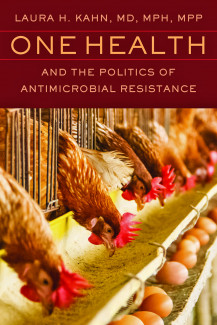
Johns Hopkins UniversityEst. 1876
America’s First Research University
Our Mysterious Microbial World

Microbes exist around us, on us, and in us. On each of us, microbial cells are believed to outnumber human cells by 10 to 1. Improvements in science and technology are allowing us to learn more about our strange, microbial world.
For the past five years, I have been investigating the political and scientific controversies surrounding the worsening global antimicrobial resistance crisis. The medical and public health communities have been blaming the veterinary medical and agriculture communities for causing the problem with their widespread use of antibiotics, particularly growth promoting antibiotics, in livestock. The veterinarians have been blaming the medical community for widespread antibiotic misuse. The blame game has been going on for years.
Many of our antibiotics come from soil bacteria. For a long time, scientists thought that soil bacteria used antibiotics as a form of “chemical warfare” against each other. It appears, however, that the real answer is much more subtle; they use minute amounts of these chemicals as a way to “talk” with each other.
We don’t know much about soil bacteria since many cannot be grown in laboratories. To get around this problem, scientists came up with the clever strategy to extract DNA directly from the soil. By doing this, they discovered that antibiotic resistance genes are everywhere and appear to be ancient. They even found antibiotic resistance genes in the arctic and Antarctic in places that have never been exposed to antibiotics. These ancient, ubiquitous antibiotic resistance genes around the world have been called, “The Global Resistome.” Our widespread use of antibiotics in humans and animals has altered the Global Resistome in ways that we don’t understand.
To illustrate, one way to think about “The Global Resistome” is to imagine resistance genes as analogous to “earplugs.” In general conversation, people talk to each other softly and don’t yell. But some of us carry around earplugs to protect our eardrums in case sounds get too loud. If we stood next to a revving jet engine long enough, it could rupture our eardrums and cause tremendous pain. We’d put on our earplugs. And if we were nice, we’d duplicate our earplugs and share them with others. In a way, this is what the bacteria are doing. Our widespread use of antibiotics is analogous to placing revving jet engines all over the world—we’re flooding the world with antibiotics. And, in response, the bacteria are expressing their resistance genes and sharing them with other bacteria to protect them against harm. As long as we continue to use antibiotics at the rates and amounts that we have been, we can expect more and more resistance genes.
We need to think strategically and work with nature rather than against it. Bacteriophages are viruses that target bacteria. They are bacteria’s natural foes. Before antibiotics were discovered and widely embraced by the medical and agriculture communities, there was considerable interest in bacteriophages. That interest disappeared. We need to reexamine bacteriophages as important adjuncts and possible alternatives to antibiotics.
Laura H. Kahn, MD, MPH, MPP, is a physician and research scholar in the Program on Science and Global Security at Princeton University’s Woodrow Wilson School of Public and International Affairs. She is the author of Who’s In Charge? Leadership during Epidemics, Bioterror Attacks, and Other Public Health Crises. Her latest book, One Health and the Politics of Antimicrobial Resistance is available now. 


